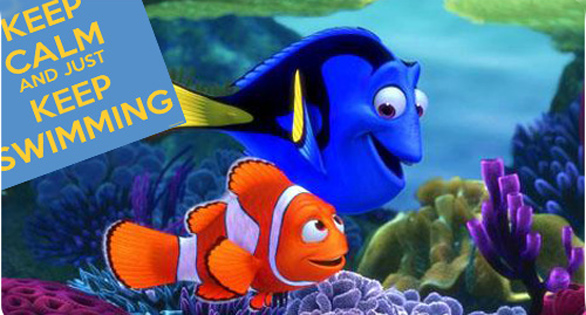
In a sequel to the tale of Nemo the clownfish, Finding Dory will appear in 2016 focusing on the Pacific Blue Tang, Dory. Image © Disney Pixar 2015.
WARNING: Finding Dory is Coming!
SAIA mounts campaign to dampen demand for Paracanthurus hepatus
Just as millions of viewers fell for Nemo, a new wave of global affection for his Pacific Blue Tang friend is predicted when Finding Dory is released by Disney Pixar Studios in June 2016.
Predicting that uninformed consumers will be inspired to buy a live “Dory” for their aquariums, a European non-profit organization is mounting an educational campaign to discourage the purchase and keeping of Paracanthurus hepatus, variously sold as the Palette Surgeonfish, Regal Tang, Blue Tang, or Pacific Blue Tang, a native of the Indo-Pacific.
Official background on the character of Dory, voice provided by Ellen DeGeneres, is provided in this Disney Wiki Site.
The full announcement from SAIA is provided here:
PRESS RELEASE
June 17, 2015
All Eyes on Dory!
SAIA campaign warns against overfishing of palette surgeonfish
The Sustainable Aquarium Industry Association (SAIA) has launched an extensive campaign to protect the palette surgeonfish on the occasion of the release of Disney’s animated feature film Finding Dory on June 17th, 2016. Finding Dory features this species as the main character, and the Disney Corporation wants to build on its 2003 success with Finding Nemo, and even surpass it.
SAIA warns, however: Should aquarists’ demand for the palette surgeonfish rise similarly to that for clownfish in 2003, local populations are threatened by overfishing.
Learning from Nemo
The blockbuster animated movie featuring a cute clownfish, Nemo, awoke, especially among children, the desire to get a “Nemo” into the home aquarium. The demand for clownfish (Amphiprion) jumped by 25 percent[1] and was satisfied by increased captive-bred and wild-caught supply. However, few hobbyists could provide appropriate conditions to the species, so many animals did not survive long. In the movie, Nemo escapes life in captivity through a drain, because supposedly all drains would lead to the sea. Countless children tried to free Nemo in the same way and, because the presumption is false, led the clownfish gradually, albeit unintentionally, to certain death.[2]
Palette surgeonfish not easy to breed
With its large-scale educational campaign, the SAIA project (organized by ESAIA e.V.) wants to prevent palette surgeonfish (Paracanthurus hepatus) from suffering a similar or even worse fate. “Palette surgeonfish, known in Indonesia as ‘Letter 6,’ are demanding animals that can be kept only by experienced aquarists and under optimal conditions,” states marine biologist and SAIA Project Manager Christiane Schmidt. “Unlike clownfish, palette surgeonfish can not be bred commercially. All fish sold would thus come from the wild. In the countries of origin, such as Indonesia, the stocks of aquarium fish are already depleted. This species could not sustain a Nemo-like onslaught.”
Movies, interviews, online workshops
The year-long SAIA campaign in advance of the Dory movie premiere is not directed against the film itself. Rather, it focuses on promoting the responsible, sustainable sourcing of aquarium fish beyond the beautiful, colourful world of cinema. The campaign kicks off with SAIA’s film Searching for “Letter 6,“ which documents the laborious process of tracking down tropical fish and the long, grueling journey the animals make from the reef to the aquarium. Throughout the year, renowned scientists and aquarists will conduct online seminars and publish articles; breeders and dealers will have their say. The organization also stands ready to advise stakeholders from industry, government, and associations, as well as hobby aquarists and all others interested in this issue.
For more information
www.saia-online.eu
ALL EYES ON DORY!
Regards,
SAIA / ESAIA e.V.
Christiane Schmidt
(Project Coordinator)
Email: vorstand@esaia.net
Footnotes
[1] Source: Oceans, Reefs & Aquariums (ORA) in: Prosek, James (2010): Beautiful Friendship.
http://ngm.nationalgeographic.com/2010/01/clownfish/prosek-text.
[2] http://en.wikipedia.org/wiki/Finding_Nemo




